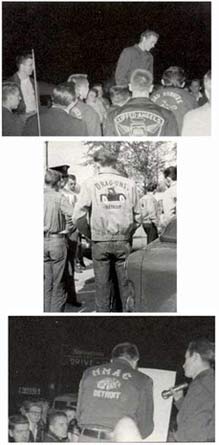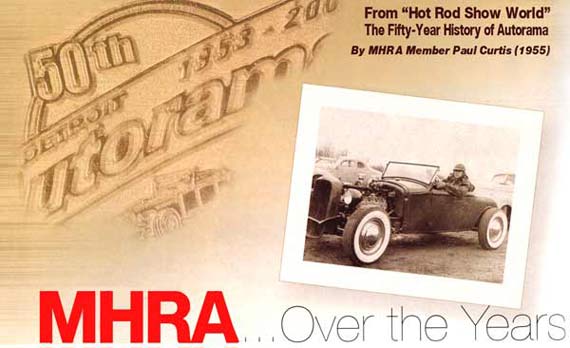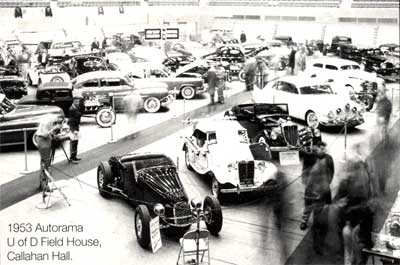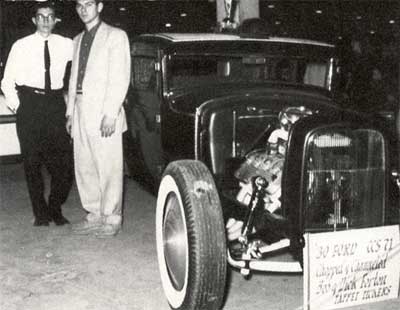Pioneers Form MHRA Perhaps the best place to start this hot rod history is to acknowledge that there have always been hot-rodders. History may call them inventors, tinkerers or mechanics. They were all enthusiasts who were not satisfied with the performance of automobiles of their day. By the 1940s these enthusiasts, for the most part, were all being labled by a new name... hot-rodders, I'm positive they were in Detroit, where I grew up. As the '50s approached, the Northwest side of Detroit was becoming the center of hot-rodding in Southeastern Michigan and the focus was on performance drag racing. Clubs, such as the Motor City Modified Auto Club (MMAC), Drag-Ons, Gear Grinders and Down River Modified, began forming in the area. A limited amount of informal drag racing was taking place on the streets, but there was no legal alternative at the time. |
 |
|
MMAC (formed in 1948) is generally credited with being the state's oldest surviving hot-rod club, and in fact, was the most active club of its day. Its members were the driving force to organize the area's clubs into the first, club-managed association in the nation... the Michigan Hot Rod Association. That all happened in 1951 with the aforementioned clubs participating as founders. Membership grew quickly as word of this new association spread. The first association meetings were quite informal, as they were held in a corner booth, in the Northwestern Drive-In at 9 Mile and Northwestern Hwy. A little more privacy was afforded when the meetings moved to the home of MHRA's co-founder, Bob Vivian (MMAC). Another co-founder, Al Clair, (MMAC) remembers moving the meetings to the garage behind his home on Five Mile Road. Early MHRA stationery carries this same address. Officers Create the First Annual Autorama MHRA's first President was Dick Stickley (MMAC) and he is credited with being the driving force behind the creation of the association. For the next year, Dick guided the association towards its first annual Autorama rod and custom car show. The Autorama was the method of choice for raising the funds to meet the young associations first goal... to build its own drag strip. That first show was held at the University of Detroit Field House, a facility that still stands as it did on January 31, 1953. Dick also was the first Autorama Chairman and history shows that the show was, indeed, a success, leading MHRA to move the show to bigger facillities each of the next two years. Road Knights member, Harry McAuliffe, remembers working for Dick at that first Autorama. The Road Knights Auto Club was the fifth club to join the new association in 1951. Drag Racing Increases ... In the meantime, informal drag racing continued until sometime in1952 when one collilected MIIRA mcmbt'r was able to get the assodation peflllis- sian to hold its drag ran's at a lillie-used Naval Air Station in nearby Newport, MI. Its runways played host to Michigan's hottt.'st iron for nearly a year before some visiting Navy brass shut il down. t\tt\lAC member Frank Burrel] built the timing lights that were used there. After that. the City of Romulus unknowingly played host to the area's drag ran.'rs at mildly orga- nized drags on lonely sections of Ecorse Road. It was 1954 when MHRA received permission from the City of Livonia to hold 6 drag races on a newly paved section of Amrhein Road behind the GM Gear and Axle Plant. The NHRA Drag Safari was on the road that year and the MHRA Drags were on their schedule as they crossed the country. Photos and the rest of the story appeared in the November issue of Hot Rod Magazine that year and in the August 22, issue of the Detroit News Pictorial. National Hot Rod Association President, Wally Parks, had appointed MHRA board member, Dick Stickley, as the NHRA Regional Advisor in 1953 and then Frank Burrell for 1954. An advisor would keep NHRA informed on association activilities and could rallupoll NHRA assistance/guidance in their racing efforts and Autorama coverage in Hot Rod Magazine. Frank wrote to Wally that there were now 31 clubs in the association. |
In October 1954, MHRA received a letter from James M. Hare, then General Manager of the Michigan State Fairgrounds, advising MHRA of their desire to set up a drag strip at the state fairgrounds. A meeting was arranged but no one knows what happened except that it did not materialize. By 1955 the Bearing Burners, MillWinders, Modifiers, Spark Plugs, Tappet Tickers (now Competition Specialists), Traction Masters, Pontiac Shifters (now Shifters), TyRods and Royal Dragmasters had swelled the association to 40 clubs. Sadly, three of the founders had already disbanded. Four Autoramas and several MHRA member assessments from these clubs provided the down payment on property on Meldrum Road south of 26 Mile Road in New Baltimore, MI. However, it would not be until 1957 that the first association owned drag strip would officially open. Before then, MHRA members would be working weekends, digging ditches, cutting brush and spreading gravel to help defray the cost of construction. During this same period MHRA conducted a Touring and Trials program which fostered competition between members and increased participation in the various club events. Many will remember the all night rallies, Lake Orion ice runs and Bald Mountain hill climbs sponpsored by MMAC and the Lake St Clair ice runs, which the Bearing Burners sponsored. Participation in these and other events would result in points that could earn participants trophies and recognition at the yearly MHRA banquet. |
|
Venue Changes With The Times Constant increases in membership prompted MHRA to move its meetings several times during the decade. These included Colony Hall on Evergreen at 8-1/2 mile Road. (Surprisingly, still looks the same!) A popular high school hangout, the Cardinal Hut, was also a MHRA meeting place. The Cardinal Hut was on Five Mile Road and Hubbel. near Cooley High and was named after the school'ssports team, the Cooley Cardinals. (Today it's a laundry!) Thc spacious activities room of the 16th Precinct at Six Mile and Grand River in Detroit also served the associations needs for a few years. Obviously a more productive environment for business but no eats! As for the order of the moves, it depends on which old-timer you ask! As club membership spread across the city it seemed proper that a more "centralized" meeting place would he appropriate and by the 1960s the MHRA board meetings were being held in the basement meeting room of Dom Polski Hall, a private club on Six Mile just east of Davison in Detroit. This location turned out to be quite suitable for Ihe next 25 years until the changing face of the neighborhood prompted a final move eastward into Warren. Pampa Lanes, on Van Dyke north of 13 Mile Road in Warren, has been the MHRA choice for meetings for the last 13 years. The spacious banquet room is quite a departure from the back booth at the Northwestern Drive-In 50 years earlier. The single important constant is that the spirit of the early association is still intact. Autorama Moves to Cobo Hall The association was into its third Autorama year and as many locations before it settled at the Michigan State Fairgrounds for a stable 5 year period. The second Autorama had also been held at the Fairgrounds and the third at the Detroit Artillery Armory. Now eight years old, the growing, exciting rod and custom show, that was destined to become the biggest of its kind in the world, took a giant leap of faith when it contracted to occupy the lower floor of the brand new Cobo Hall in Downtown Detroit. While not in favor of the move, no other person was more responsible for the Autorama moving to larger uarters, than promoter Don Ridler. His innovative approach brought us big bands and personalities and increased the attendance dramatically. It was at this point that Bob Larivee (MMAC) left his chairman position in MHRA to become the producer of Autorama. Don and Bob's stories and the Detroit Autorama are covered elsewhere in this program. MHRA's Goal Met... Let the Racing Begin When the strip opened in 1957 countless eager racers welcomed it across the state. MHRA workers manned the starting line with push brooms. Club members installed and operated the timing system, recorded the wins and controlled traffic Lee Lasky (Sad Sacks) was flagman for many years of the strips history, with all enthusiasm that gave every race the appearance of an important top eliminator run. Strip managers during these years included Bob Larivee, Al Dortenzio (MMAC) and Lee Lasky. By the mid 1960s the MHRA had leased the strip to Motor City Dragway. The state had seen several more strips open over the past ten years and racers now had a wider choice of race venues to choose from. In November 1968, the MHRA board of directors sold the facility and retired from the drag race business. The MHRA Prewar Rod Tour MHRA felt that it would be a great idea to provide a major summer event for area rod and custom owners. The year was 1967 and MHRA initiated what would soon become a national pastime... rod runs. That first weekend drew only 17 cars but was considered a success. Each outing following that first run saw increased participation and greater events. By 1972, there were so many rod runs being produced that MHRA discontinued its series in favor of supporting other organizations. Over this 6-year period MHRA produced 10 runs. Destination cities included: Battle Creek, MI; Sarnia, Ont. (twice); Benton Harbor, MI; London, Ont.; Troy, OH; Grand Rapids, MI (twice); Ann Arbor, MI; and Saginaw, MI. The Benton Harbor run was co-sponsored by MHRA, ISCA and Pop Hot Rodding Magazine and can be seen in Argus Publisher's Winter 1971 issue of 1001 Custom and Rod Ideas. |
 |
New Ventures Support Autorama As the '60s drew to a close the association broadened its efforts to promote the Autorama on a year-around basis. One such endeavor was the initiation of the MHRA Newsletter, all 8-page color publication that covered the Autorama and listed all the winners. It also covered the MHRA rod runs. This was published for three years. A second program was the Autorama Show Car Products Iine of automotive chemicals. A chemical supplier to the big three auto companics approached MHRA offering to private label their products. In as much as the items had already been tested and approved by the auto industry MHRA agreed to initiate a line of three chemicals... a polish, a wax and upholstery cleaner. In filing for a copyright MHRA discovered that an Illinois firm already marketed a like product using the name Autorama.The new line, renamed MHRA Show Car Products, was unveiled at the Detroit Autorama and was distributed locally for the next two years. MHRA Joins the Producers Association In The '70s saw MHRA emerge as producer of the annual Port Huron, MI Autorama. This 1-A Show ran for 25 years a few weeks following the Detroit Autorama and was always loaded with high-quality cars. MHRA Rod Repair Shop Opens The early rod tours taught us that whatever hot-rodders will build, bad roads can sometimes tear appart. MMAC member and GM engineer, Frank Burrell realized that when the first tour started and followed the group with a complete repair shop. When NSRA held its Nationals meet in Detroit in 1972, MHRA members furnished the tools and labor to open the first Rod Repair Shop. |
By the following summer Dick Forton (Competition Specialists) had conceived the idea for a Rod Repair Trailer. The MHRA Rod Repair Shop has traveled across the country serving thousands of hot-rodders attending NHRA events over the past 30 years. MHRA Sponsors the Soap Box Derby The Soap Box Derby suffered a setback in the '70s with the unfortunate loss of a longtime sponsor. Recognizing an Autorama promotion opportunity, MHRA picked up the local sponsorship and assisted the group into the next decade. The 1980's also saw the beginning of the Autorama Demo Derby and the Calendar of Events. The demo derby pitted the seven MHRA Clubs in an exciting summer competition. It was a great way to publicize MHRA and Autorama. Each year, for the past 15 years at Autorama, area automotive clubs have been invited to be MHRA guests at the Autorama Calendar of Events meeting to plan the next 12 months activities. This has met with considerable participation as clubs can coordinate their events to help avoid an excess of overlapping events. The combined list is then published and distributed, in quantity, to participating clubs. |






